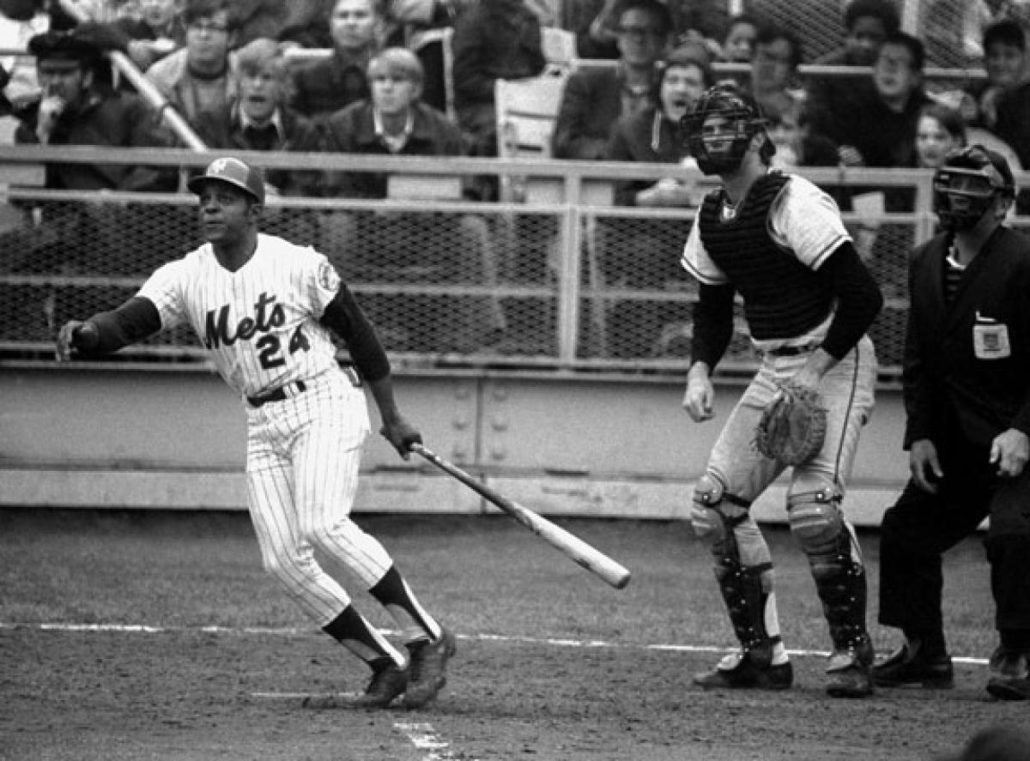
Willie Mays.
We’re looking back at the 50th anniversary of the Mets’ 1973 National League pennant-winning team by reviewing the most inspirational figures of that remarkable run. We continue with one of the greatest players of all-time, who made the last stop of his legendary career where it all started.
On the evening of September 25, 1973, at Shea Stadium, a 42-year-old legend was honored by the city that saw him grow up. Five days earlier, he had announced his retirement at season’s end—the close to a tremendous career that began in 1951. While still a strong presence in the clubhouse, he hadn’t played since September 9. He was batting .211 with six home runs and 25 RBIs over 253 plate appearances—far from what fans were used to seeing.
For his entire career on the baseball field, Willie Mays exuded confidence. An incredible talent who knew his abilities—of which there were many. But on this night, “Willie Mays Night,” he could be seen next to owner Joan Payson, a former New York Giants stakeholder who insisted on trading for Willie the year before, with tears in his eyes.
Mays, as he put it in his pregame speech to the 53,000-plus, was saying “goodbye to America.” Initially, he intended to quit before the schedule ran out. Payson convinced him otherwise. But as the Mets were streaking toward a division title, there would be time for Mays to provide more moments—where the appreciation for his career was acknowledged and where vulnerabilities on the field continued to be shown.
Mays went from the Giants to the Mets in May 1972 with the pages his storybook career yellowing at the edges. Yet, his star had yet to fade.
It still seemed more sentimental than practical. Mays had hit .184 across 67 at-bats, drove in three runs, and was without a home run. But for the greatest center fielder ever, who stirred at the notion that the team he helped for so long found him expendable, it was a measure of motivation. Especially when his first game as a Met came against the Giants on a damp Shea afternoon. In the fifth inning, he provided another legendary moment—his first homer of the year and the 647th of his career.
Diminished in ’72, he was even less of himself in ’73. Even as it appeared we’d only see Willie Mays in ceremony, there he was at the plate, a pinch-hitter for Ed Kranepool in the fifth inning of the deciding game of the NLCS with the bases loaded and New York up 3-2. Shea gave him a rousing ovation as he stepped in to hit.
Mays made slight contact on the first pitch, the ball bounced off the plate and high into the air. No Reds’ fielder could gather it in time. A run scored and Mays was safe at first.
It would be 7-2 once Tug McGraw recorded the final out. New York was in the World Series against Oakland. Bay Area fans greeted the returning Mays with loud cheers when he was introduced before Game 1. He was a focal point the next day.
New York’s 6–4 ninth-inning lead in Game 2 withered under the late afternoon sun. An aching Mays, back playing in center field, showed why not even he can’t defeat Father Time. His stumbling attempt to snag a fly ball that he used to basket catch in his sleep began an Athletics’ rally that concluded with Gene Tenace’s tying single.
Bud Harrelson tried to put a quick end to the tie in the tenth, but was ruled out on an attempt to score on a fly out to left fielder Joe Rudi. Slow-motion replay showed that catcher Ray Fosse missed the tag. Mays, on both knees, was among several who furiously contested the missed call.
The controversy abated two innings later, when Mays atoned with an RBI single to center—the final hit of his career. Three additional runs came across with the help of errors from Mike Andrews on two consecutive plays.
As a weary McGraw, working his seventh inning in relief, tried to close it out, another Mays misplay let Reggie Jackson triple and prolonged the game. This, sadly, is both Mays’ legacy as a Met player and the lasting final image of a one of the greatest players ever.
Mays had one more career at-bat; two nights later, again as a pinch hitter. After 1973, Willie maintained his ties with the Mets and temporarily severed them with the Giants. He remained in the orange and blue as a coach for the next six years. Eventually, the Giants welcomed him back.
Mays’ legacy, and the keeping of promise made by Payson more than 50 years ago, has been maintained with the retirement of No. 24 at Citi Field last season. While not a recognition of performance with the Mets in the twilight of his career, it’s a worthy tribute by a player who dominated New York National League baseball like few others.
















